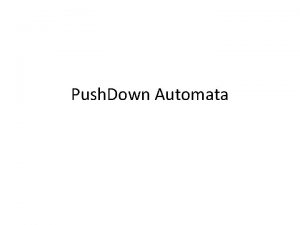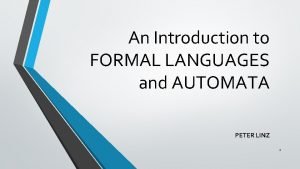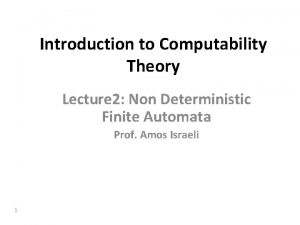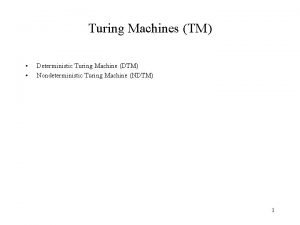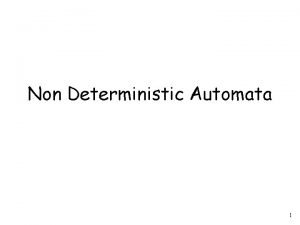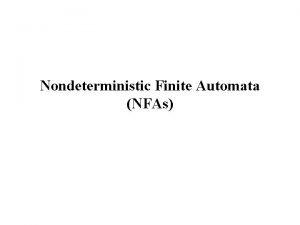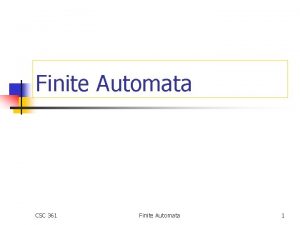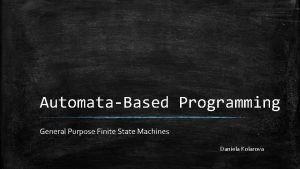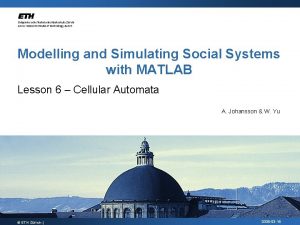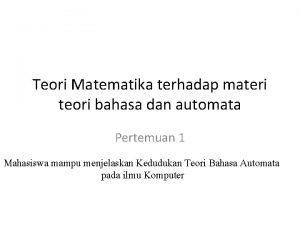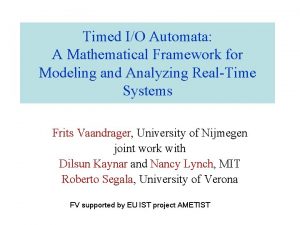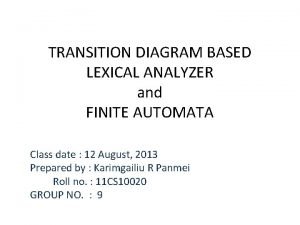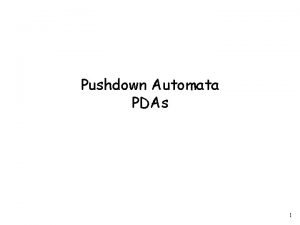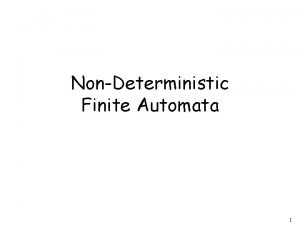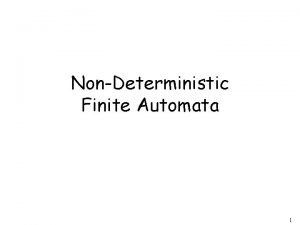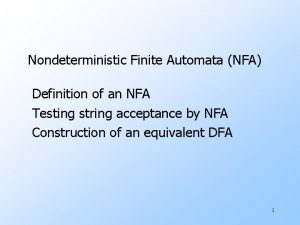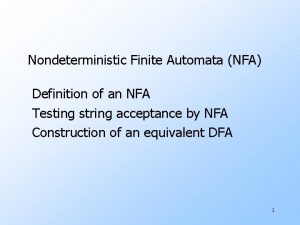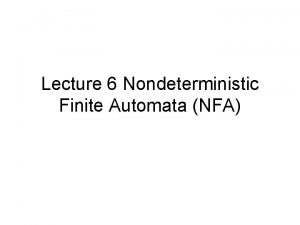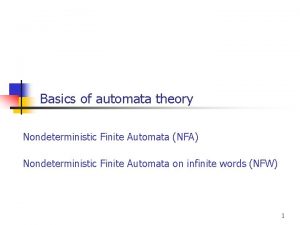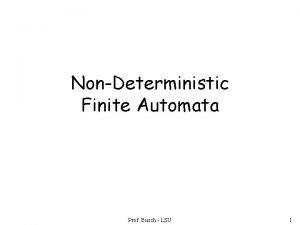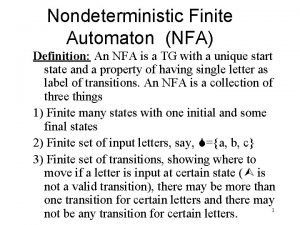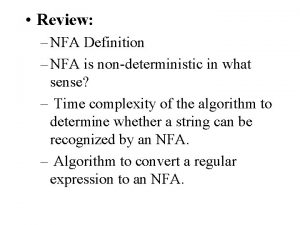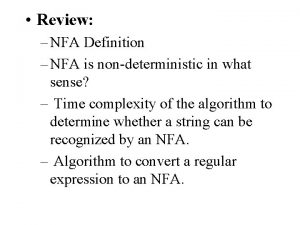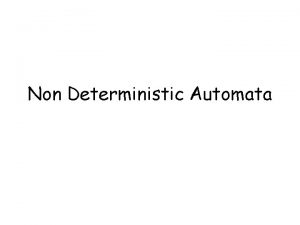NFA defined NFA A Nondeterministic Finitestate Automata NFA













- Slides: 13

NFA defined

NFA • A Non-deterministic Finite-state Automata (NFA) is a language recognizing system similar to a DFA. • It supports a level of non-determinism. I. e. At some points in time it is possible for the machine to take on many next-states. • Non-determinism makes it easier to express certain kinds of languages.

Nondeterministic Finite Automata (NFA) • When an NFA receives an input symbol a, it can make a transition to zero, one, two, or even more states. – each state can have multiple edges labeled with the same symbol. • An NFA accepts a string w iff there exists a path labeled w from the initial state to one of the final states. – In fact, because of the non-determinism, there may be many states labeled with w

Example N 1 • The language of the following NFA consists of all strings over {0, 1} whose 3 rd symbol from the right is 0. 0 0 Q 1 0, 1 Q 2 0, 1 Q 3 1 • Note Q 0 has multiple transitions on 0

Example N 2 • The NFA N 2 accepts strings beginning with 0. Q 0 0 Q 2 0, 1 • Note Q 0 has no transition on 1 – It is acceptable for the transition function to be undefined on some input elements for some states.

NFA Processing • Suppose N 1 receives the input string 0011. There are three possible execution sequences: • q 0¾® q 0 • q 0¾® q 1¾® q 2¾® q 3 0 0 Q 1 0, 1 Q 2 0, 1 Q 3 1 • Only the second finishes in an accept state. The third even gets stuck (cannot even read the fourth symbol). • As long is there is at least one path to an accepting state , then the string is accepted.

Implementation • Implementation of NFAs has to be deterministic, using some form of backtracking to go through all possible executions. • Any thoughts on how this might be accomplished?

Formal Definiton • An NFA is a quintuple A=(Q, S, s, F, T), where the first four components are as in a DFA, and the transition function takes values in P(Q) (the power set of Q) instead of Q. Thus – T: Q S ¾®P(Q) note that T returns a set of states • A NFA A =(Q, S, s, F, T), accepts a string x 1 x 2. . xn (an element of S* ) iff there exists a sequence of states q 1 q 2. . qnqn+1 such that • q 1 = s • • qi+1 Є T(qi, xi) Qn+1 Ç F ¹ Æ Compare with A DFA A =(Q, S, s, F, T), accepts a string x 1 x 2. . xn (an element of S*) iff There exists a sequence of states q 1 q 2. . qnqn+1 such that 1. q 1 = s T(qi, xi) 2. qi+1 = 3. Qn+1 is an element of F

The extension of the transition function • Let an NFA A=(Q, S, s, F, d) • The extension d : Q S* ¾®P(Q) extends d so that it is defined over a string of input symbols, rather than a single symbol. It is defined by – d(q, e)={q} – d(q, ua) = p d(q, u) d(p, a), Compute this by taking the union of the sets d(p, a), where p varies over all states in the set d(q, u) • First compute d(q, u), this is a set, call it S. • for each element, p in S, compute d(p, a), • Union all these sets together.

Another NFA Acceptance Definition • An NFA accepts a string w iff d(s, w) contains a final state. The language of an NFA N is the set L(N) of accepted strings: • L(N) = {w | d(s, w) Ç F ¹ Æ} • Compare this with the 2 definitions of DFA acceptance in last weeks lecture. A DFA A =(Q, S, s, F, T), accepts a string x 1 x 2. . xn (an element of S*) iff there exists a sequence of states q 1 q 2. . qnqn+1 such that 1. q 1 = s T(qi, xi) 2. qi+1 = 3. Qn+1 is an element of F L(A) = {w | T(s, w) F}

compute d(q 0, 000) • d(q, ua) = p d(q, u) d(p, a) 0 0 Q 1 0, 1 Q 2 0, 1 Q 3 1 • • d(q 0, 000) = x d(q 0, 00) d(x, 0) d(q 0, 00) = y d(q 0, 0) d(y, 0) d(q 0, 0) = {q 0, q 1} d(q 0, 00) = y {q 0, q 1} d(y, 0) d(q 0, 00) = {q 0, q 1} {q 2} = {q 0, q 1, q 2} d(q 0, 000)= x {q 0, q 1, q 2} d(x, 0) d(q 0, 000)={q 0, q 1} {q 2} {q 3} d(q 0, 000)={q 0, q 1, q 2, q 3}

Intuition • At any point in the walk over a string, such as “ 000” the machine can be in a set of states. • To take the next step, on a character ‘c’, we create a new set of states. Those reachable from the old set on a single ‘c’

0 0 Q 0 0, 1 Q 2 0, 1 Q 3 1 0 1 {Q 0} {Q 0, Q 1} {Q 0, Q 1, Q 2} {Q 0, Q 1, Q 3} {Q 0, Q 1, Q 2} {Q 0, Q 3} {Q 0, Q 1} {Q 0, Q 1, Q 2} {Q 0, Q 1, Q 2, Q 3} {Q 0, Q 1, Q 2, Q 3} {Q 0, Q 1, Q 3} {Q 0, Q 2, Q 3} {Q 0, Q 3}
